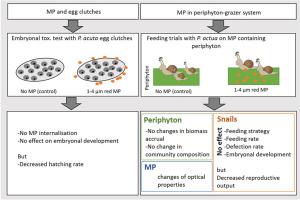当前位置:
X-MOL 学术
›
Environ. Pollut.
›
论文详情
Our official English website, www.x-mol.net, welcomes your feedback! (Note: you will need to create a separate account there.)
Fate and effects of microplastic particles in a periphyton-grazer system
Environmental Pollution ( IF 8.9 ) Pub Date : 2024-03-14 , DOI: 10.1016/j.envpol.2024.123798 Stephanie N. Merbt , Alexandra Kroll , Linn Sgier , Ahmed Tlili , Kristin Schirmer , Renata Behra
Environmental Pollution ( IF 8.9 ) Pub Date : 2024-03-14 , DOI: 10.1016/j.envpol.2024.123798 Stephanie N. Merbt , Alexandra Kroll , Linn Sgier , Ahmed Tlili , Kristin Schirmer , Renata Behra

|
In the aquatic environment, microplastic particles (MP) can accumulate in microbial communities that cover submerged substrata, i.e. in periphyton. Despite periphyton being the essential food source for grazers in the benthic zones, MP transfer from periphyton to benthic biota and its ecotoxicological consequences are unknown. Therefore, in this study, we investigated the effects of 1) MP on embryonal development of freshwater gastropod embryos, 2) MP on adult individuals through dietary exposure and 3) on the MP surface properties. Embryonal development tests were carried out with spherical polyethylene MP in the size of 1–4 μm (MP). Over a period of 28 days, embryonal development and hatching rate were calculated. In the feeding experiments, periphyton was grown in the presence and absence of MP and was then offered to the adult for 42–152 h. The snails readily ingested and subsequently egested MP, together with the periphyton as shown by MP quantification in periphyton, snail soft body tissue and feces. No selective feeding behavior upon MP exposure was detected. The ingestion of MP had no effect on mortality, feeding and defecation rate. Yet, the reproductive output of snails, measured as the number of egg clutches and numbers of eggs per clutch, decreased after the ingestion of MPs, while the hatching success of snail embryos those parents were exposed remained unaffected. In contrast, hatching rate of snail embryos was significantly reduced upon direct MP exposure. MP optical properties were changed upon the incorporation into the periphyton and the passage through the digestive tract. Our results indicate that MP incorporated in periphyton are bioavailable to aquatic grazers, facilitating the introduction of MP into the food chain and having direct adverse effects on the grazers’ reproductive fitness.
中文翻译:

附生生物-食草动物系统中微塑料颗粒的命运和影响
在水生环境中,微塑料颗粒(MP)可以积聚在覆盖水下基质的微生物群落中,即附生植物中。尽管附生生物是底栖食草动物的重要食物来源,但MP从附生生物到底栖生物群的转移及其生态毒理学后果尚不清楚。因此,在本研究中,我们研究了 1) MP 对淡水腹足动物胚胎胚胎发育的影响,2) MP 通过饮食暴露对成年个体的影响,以及 3) MP 表面特性的影响。使用尺寸为1-4μm(MP)的球形聚乙烯MP进行胚胎发育测试。在 28 天的时间内,计算胚胎发育和孵化率。在摄食实验中,附生生物在存在和不存在 MP 的情况下生长,然后提供给成虫 42-152 小时。蜗牛很容易摄入并随后排出 MP 以及附生生物,如附生生物、蜗牛软体组织和粪便中 MP 定量所示。没有检测到 MP 暴露后的选择性进食行为。 MP的摄入对死亡率、摄食和排便率没有影响。然而,摄入 MP 后,蜗牛的繁殖产量(以产卵数量和每窝产卵数量来衡量)有所下降,而父母接触的蜗牛胚胎的孵化成功率却未受影响。相比之下,直接接触 MP 后,蜗牛胚胎的孵化率显着降低。 MP 的光学特性在融入附生生物和通过消化道时发生变化。我们的结果表明,附生生物中的 MP 对水生食草动物具有生物利用度,促进 MP 进入食物链并对食草动物的繁殖适应性产生直接的不利影响。
更新日期:2024-03-14
中文翻译:

附生生物-食草动物系统中微塑料颗粒的命运和影响
在水生环境中,微塑料颗粒(MP)可以积聚在覆盖水下基质的微生物群落中,即附生植物中。尽管附生生物是底栖食草动物的重要食物来源,但MP从附生生物到底栖生物群的转移及其生态毒理学后果尚不清楚。因此,在本研究中,我们研究了 1) MP 对淡水腹足动物胚胎胚胎发育的影响,2) MP 通过饮食暴露对成年个体的影响,以及 3) MP 表面特性的影响。使用尺寸为1-4μm(MP)的球形聚乙烯MP进行胚胎发育测试。在 28 天的时间内,计算胚胎发育和孵化率。在摄食实验中,附生生物在存在和不存在 MP 的情况下生长,然后提供给成虫 42-152 小时。蜗牛很容易摄入并随后排出 MP 以及附生生物,如附生生物、蜗牛软体组织和粪便中 MP 定量所示。没有检测到 MP 暴露后的选择性进食行为。 MP的摄入对死亡率、摄食和排便率没有影响。然而,摄入 MP 后,蜗牛的繁殖产量(以产卵数量和每窝产卵数量来衡量)有所下降,而父母接触的蜗牛胚胎的孵化成功率却未受影响。相比之下,直接接触 MP 后,蜗牛胚胎的孵化率显着降低。 MP 的光学特性在融入附生生物和通过消化道时发生变化。我们的结果表明,附生生物中的 MP 对水生食草动物具有生物利用度,促进 MP 进入食物链并对食草动物的繁殖适应性产生直接的不利影响。



























 京公网安备 11010802027423号
京公网安备 11010802027423号